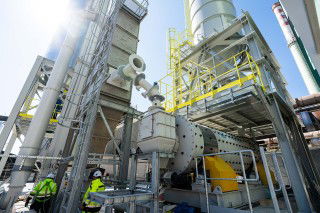This week Asia Cement announced that it would be employing TCRK's Arago Cement Process to utilise captured CO2, cement kiln dust and by-pass particles in the cement production process in South Korea from 2025. ICR reviews the opportunities for carbon capture utilisation and storage (CCUS) for cement producers in the Asian region.
The Asia Cement Co project will include a fully commercial-scale deployment of TCRK CCUS technology. Initially it will target 30,000tCO2e per year, rising to 120,000tCO2e per year over the first 18 months after start-up. The initiative will aim to achieve 20 per cent of the Asia Cement's targeted emission reductions by 2025. The company will produce a lower-carbon cement product and cultivate microalgae for biomass as CO2 utilisation solutions. The carbon-neutral cement product will be called Arago Cement. The microalgae are grown by bio-fixation, enabling 10 per cent extra carbon storage capacity, says Asia Cement.
South Korea's Ministry of Science announced on 15 June 2021 that it plans to commercialise 14 CCUS products by 2030. The ministry has already committed to investing US$89.5m annually in carbon capture from 2023. Furthermore, it plans to cut the price of captured carbon from US$70/t to US$20/t by 2050.
Leading Asian CCUS projects
Asia Cement's commitment to CCUS may well encourage more such projects in north and southeast Asia. Presently, the Anhui Conch 50,000tpa Baimashan CCUS project in China and Taiwan Cement’s Hoping CCUS project are the most established decarbonisation trials in the region. India will also invest heavily in CCUS. Dalmia Cement has already begun testing a CCUS facility at its Ariyalur cement plant in Tamil Nadu. The plant will have a carbon capture capacity of 0.5Mta. The plant will use Carbon Clean Solutions' CDRMax technology. Dalmia Cement has ambitiously forecast that it will reach net zero emissions by 2040. Analysts will be keen to see what India's second-largest cement producer, Adani Cement, commits to for its ACC Ltd and Ambuja Cement businesses, which it recently acquired from Holcim. Adani Group has already committed to make its ports-to-power business conglomerate carbon negative by 2025.
Indonesia and Vietnam’s high CCUS potential
The IEA recently released a report entitled 'Carbon Capture Utilisation and Storage: The opportunity in Southeast Asia'. It states that at 180Mt, cement production is the largest source of industrial emissions in the region. Vietnam and Indonesia produce the highest volumes of cement in southeast Asia. Cement accounts for eight per cent of Indonesia’s CO2 emissions. The power sector is accountable for 44 per cent of Indonesia's CO2 emissions. Plans are in progress to try and build industrial clusters to incorporate the cement sector in Indonesia and Vietnam. Vietnam's industry is concentrated in the north. CO2 storage areas are curently under investigation. Saline aquifers offer potential storage capabilities in the Natuna region of Indonesia.
North Asian CCUS projects
In north Asia, Mitsubishi Heavy Industries Engineering Ltd (MHIE) is leading the CCUS technology implementation with its pilot plant at Tokuyama Corp’s Shunan Cement works, which began in June 2022. MHIE, together with the Kanasia Electric Porter Co has been developing 'KM Process' and 'Advanced KM CDR Process' CO2 capture technologies since the 1990s.
Taiwan Cement’s Ho-Ping cement plant has operated the largest calcium looping facility since 2013. The CO2 capture rate is 1tph and can capture 450,000t of CO2 per annum via HECLOT technology from the Industrial Technology Research Institute. CO2 capture efficiency from flue gases has exceeded 90 per cent. The plant has integrated hydration reaction into the calcium looping process to improve the reaction activity of the sorbent. Meanwhile, the cascade cyclone system reduces heat loss and increases efficiency. Taiwan is also plentifully resourced with coastal and offshore deep saline aquifiers for CO2 storage.
Summary
Asia could well find itself quickly catching up in the decarbonisation race with its natural resources for CO2 storage. Its large industrial hubs could make large-scale decarbonisation with public funding achievable in a shorter time period. There could also be some cross-border cooperation for creating industrial clusters to decarbonise. However, many of these countries are undergoing population growth. They are also experiencing higher urbanisation as they look to decarbonise. Anhui Conch has already stated the early development of its CCUS technology has not been cost effective. Finding end markets for the captured CO2 has been more difficult than expected. As well as having the technology installed to capture CO2, cement producers require adequate storage and utilisation options.
